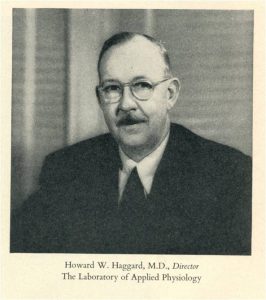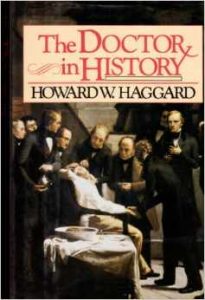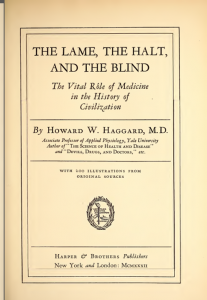Howard W. Haggard

Howard W. Haggard
Dr. Howard W. Haggard (1891-1959) was the first director of the Yale Laboratory of Applied Physiology. Among the many initiatives Haggard led was the birth of the modern study of alcoholism. His research team on alcoholism, the Section On Studies of Alcohol, later grew into the Yale Center of Alcohol Studies, which found a new home at Rutgers University in 1962.
Haggard began his career in respiratory physiology, influenced by his work on chemical weapons for the Army during the First World War. As his reputation grew, he moved into anesthesiology and supplemented his research with textbooks and popular science bestsellers. Haggard moved into the burgeoning field of alcohol studies after the repeal of National Prohibition and, in 1940, became the inaugural editor and president of the corporation of the Quarterly Journal of Studies on Alcohol, now the Journal of Studies on Alcohol and Drugs. Under the aegis of the Yale Laboratory for Applied Physiology, he also assembled and oversaw what would become the Center of Alcohol Studies. Haggard died in 1959, his legacy established as a central figure in the 20th-century transformation of alcohol studies in the United States.
A prolific researcher with a talent for tapping into the public zeitgeist, Haggard helped provide the institutional infrastructure, academic credibility, and broad audience that made the renaissance of alcohol studies in post-Prohibition America possible.”
Read more:
Allred, N., Bejarano, W., & Ward, J. (2017). Howard Wilcox Haggard and the Institutionalization of Modern Alcohol Studies. Journal of Studies on Alcohol and Drugs, 78(2), 325-329.
-
 Dr. Howard W. Haggard was born in La Porte, Indiana in 1891. He attended the prestigious Phillip Exeter Academy in New Hampshire before entering Yale, where he earned both a bachelors and a medical degree. After finishing medical school in 1917, he was a captain in the Army Chemical Warfare Service during World War I.
Dr. Howard W. Haggard was born in La Porte, Indiana in 1891. He attended the prestigious Phillip Exeter Academy in New Hampshire before entering Yale, where he earned both a bachelors and a medical degree. After finishing medical school in 1917, he was a captain in the Army Chemical Warfare Service during World War I.In 1919, Haggard returned to Yale as a faculty member and spent the rest of his career at the university. Working closely with Dr. Yandell Henderson, Haggard pioneered physiological research in mine rescue; prevention of industrial poisoning; decompression in diving; and resuscitation from drowning, gassing, and electric shock. His work led to improvements in anesthesia and the development of the modern gas mask.
Haggard’s physiology textbook The Science of Health and Disease appeared in 1927 and was republished multiple times over the following decades. He reached an even greater audience in 1929 with Devils, Drugs, and Doctors, which went through at least 25 printings in its first year alone, was translated around the world, and earned Haggard a nationally syndicated radio show in 1931. For the rest of his career Haggard supplemented his medical research with addresses and publications for general and lay audiences, including his 1934 bestseller The Doctor in History.
One of Haggard’s primary interests was the effect of alcohol on the human body. After the repeal of national prohibition in the 1930s, Haggard’s Section on the Study of Alcohol did some of the first research that combined many disciplines to develop treatment for alcoholism. This division would eventually become the Yale Center of Alcohol Studies. Haggard was the founding editor of the Quarterly Journal of Studies on Alcohol (now JSAD) in 1940 and co-authored Alcohol Explored with E. M. Jellinek in 1942. Haggard’s talent for outreach helped shape the ecumenical approach and educational mission of the Center. Haggard was a central figure in the Summer School of Alcohol Studies; two lectures he delivered there appear in Alcohol, Science, and Society (1945), as well as a foreword he wrote specifically for the collection.
Dr. Haggard died on April 21, 1959 in Ft. Lauderdale, Florida. He left behind a legacy as an innovative researcher, a talented and enthusiastic teacher, and a passionate ambassador for medicine.
-
1891: Born July 18 in La Porte, Indiana
1914: Graduates from Yale University
1917: Graduates from Yale Medical School
1917-1919: Serves as captain in the army Chemical Warfare Service during World War I.
1919: Joins Yale Medical School faculty as instructor of physiology.
1926: Made professor; becomes first director of the Yale Laboratory of Applied Physiology.
1929: Publishes Devils, Drugs, & Doctors
1930: Begins studies on the effects of alcohol on the human body.
1933: Publishes Mystery, Magic, & Medicine
1940: Founds theQuarterly Journal of Studies on Alcohol. Serves as editor until his death.
1943: First Summer School of Alcohol Studies hosted at Yale. Formally establishes the Section on Alcohol Studies.
1944: Yale Clinic Plan opens – first outpatient treatment center for alcoholism.
1950: Section renamed the Yale Center of Alcohol Studies.
1956: Retires from directorship at Yale. Continues to edit QJSA.
1959: Dies April 21, 1959 in Ft. Lauderdale
-
In his own time, Haggard scarcely needed introduction. He was a lion of the faculty at Yale, a best-selling author, and a sought-after speaker for academic and lay audiences alike. Practically an institution unto himself, Haggard set up and managed some of the major institutions of 20th-century alcohol studies, including the Quarterly Journal of Studies on Alcohol and Drugs.
 Haggard also played a crucial role in the design, support, management, publication, and dissemination of the field’s central texts in the formative decade after the repeal of National Prohibition.
Haggard also played a crucial role in the design, support, management, publication, and dissemination of the field’s central texts in the formative decade after the repeal of National Prohibition.Publication highlights
- Haggard, H. W. (1929). Devils, drugs, and doctors: The story of the science of healing from medicine-man to doctor. New York: Harper & Brothers. (full text available from the Internet Archive)
- Haggard, H. W., & Jellinek, E. M. (1942). Alcohol explored. New York: Doubleday, Doran & Company, Inc. (full text available from the Internet Archive)
Downloads
- Haggard’s full bibliography
-
 By Haggard
By HaggardAbout Haggard
Allred, N., Bejarano, W., & Ward, J. (2017). Howard Wilcox Haggard and the Institutionalization of Modern Alcohol Studies. Journal of Studies on Alcohol and Drugs, 78(2), 325-329.
Download full bibliography